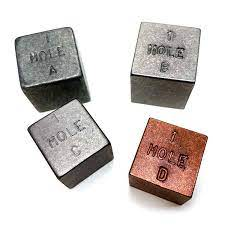10 Density
Density Basics
Density is a ratio of mass to volume of a substance. Density can be used to determine the identity of a substance.
Density (D) = Mass (M)/Volume (V)
The most common unit for density is grams/cm3, but this can also be grams/mL. The cm3 is equal to 1mL and is a common conversion based that relates back to water.
Solve each problem provided the given information.
- If an object has a mass of 30g and a volume of 15g, what is its density?
- If a piece of aluminum has a volume of 35ml and a mass of 91g, what is its density?
- Aquamarine, the birth stone of March, has a density of 2.70g/cm3. If a stone is 10cm x 2cm x 1cm, what is the mass of the stone?
- A piece of gold has a density of 19.3g/cm3. It was measured to have a mass of 32g, so what is the volume of the piece?
The next problem is based on a set of unknowns as shown in the picture.
 We know the identities of the items based on the packaging and that information is provided below.
We know the identities of the items based on the packaging and that information is provided below.
Package contains:
Copper Density = 8.96 g/cm3
Iron Density = 7.87 g/cm3
Zinc Density = 7.14 g/cm3
Aluminum Density = 2.60 g/cm3
Unfortunately, we needed to take measurements to determine match the information with the blocks. The following information was collected. The blocks are 20mm cubes.
Block A has a mass of 62.96g.
Block B has a mass of 57.12g.
Block C has a mass of 20.80g.
Block D has a mass of 71.68g.
Calculate the densities and identify the composition of the blocks.
